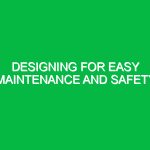In the ever-evolving landscape of the modern workplace, ensuring safety and minimizing risks associated with infectious diseases has become paramount. The concept of safe design principles for workplace equipment focuses on creating an environment where equipment is designed with the health and safety of employees in mind. This principle is particularly relevant in the context of Health, Safety, and Environment (HSE) practices. In this article, we will explore these principles, the associated risks, safety precautions, and relevant regulations that guide safe practices in workplace design.
Understanding Safe Design Principles for Workplace Equipment
To grasp the essence of safe design principles, we first need to understand what they entail. Safe design principles advocate for the integration of safety considerations into the design and manufacture of workplace equipment. This approach emphasizes prevention over reaction, aiming to eliminate hazards before they can affect employees. The focus on infectious diseases highlights the need for equipment that minimizes the transmission of pathogens, thereby protecting the health of employees.
For instance, consider the COVID-19 pandemic, which forced many organizations to reevaluate how equipment is used and maintained. The design of shared equipment, such as printers or kitchen appliances, became a focal point. Organizations began implementing touchless technologies and increased the frequency of cleaning protocols. Such actions underscore the importance of safe design principles in response to real-world health crises.
Identifying Hazards and Risks
When discussing safe design principles for workplace equipment, it is essential to identify potential hazards and risks, particularly those related to infectious diseases. Several factors can contribute to these risks:
1. Contaminated Surfaces
Shared equipment can harbor pathogens on their surfaces. High-touch areas, such as doorknobs, shared tools, and equipment controls, are prime spots for the transmission of infectious diseases. A study published in the Journal of Infectious Diseases found that many respiratory viruses can survive on surfaces for several days, highlighting the need for careful design and maintenance.
2. Poor Air Quality
Inadequate ventilation can lead to the accumulation of airborne pathogens, increasing the risk of disease transmission. This is particularly relevant in enclosed spaces where equipment generates heat or particles. For instance, a manufacturing facility that lacks proper airflow may see higher incidences of respiratory infections among workers.
3. Ineffective Personal Protective Equipment (PPE)
If equipment is designed without considering the need for PPE, the risk of exposure to infectious agents increases. For example, laboratory equipment must be designed to accommodate gloves and masks without hindering functionality. Failure to do so can lead to unsafe practices and increased health risks.
Safety Precautions and Best Practices
Implementing safe design principles requires actionable safety precautions. Here are several best practices that can significantly mitigate risks associated with workplace equipment:
1. Incorporating Antimicrobial Materials
Using materials that resist microbial growth can play a vital role in reducing infection rates. For example, touch surfaces can be made from copper or coated with antimicrobial agents. In a healthcare setting, using such materials in frequently touched areas has shown to reduce the spread of infections.
2. Designing for Easy Cleaning
Equipment should be designed with cleaning in mind. Smooth surfaces, removable components, and minimal crevices can make cleaning more effective. In a restaurant setting, for instance, equipment like dishwashers must have designs that allow for easy access to all parts, facilitating thorough sanitation.
3. Implementing Touchless Technology
Adopting touchless technology can significantly reduce the risk of surface transmission. For example, motion-activated faucets and automatic doors minimize the need for physical contact. A case study at a busy airport showed that implementing touchless check-in processes reduced the number of health-related incidents significantly.
4. Ensuring Proper Ventilation
Good ventilation is crucial for minimizing airborne pathogens. Employers should ensure that workspaces are equipped with adequate HVAC systems that filter and exchange air regularly. A manufacturing plant that upgraded its ventilation system reported a drop in respiratory illness cases among its employees.
5. Training Employees on Safe Practices
Training employees on the safe use of equipment and the importance of hygiene can empower them to take proactive measures. Regular workshops that focus on the risks associated with workplace equipment can lead to a more safety-conscious culture. Real-life examples from the hospitality industry show that staff training can significantly curb incidences of foodborne illnesses.
Regulations and Standards
Several regulations and standards govern the safe design principles for workplace equipment, particularly concerning infectious diseases:
1. Occupational Safety and Health Administration (OSHA)
OSHA sets forth general duty clauses that require employers to provide a workplace free from recognized hazards. This includes ensuring that workplace equipment is designed and maintained to prevent employee exposure to infectious diseases.
2. Centers for Disease Control and Prevention (CDC)
The CDC provides guidelines on infection control practices in various sectors, including healthcare and manufacturing. These guidelines emphasize the importance of equipment design in minimizing infection risks.
3. American National Standards Institute (ANSI)
ANSI standards outline requirements for safe equipment design and operation. Compliance with these standards can help organizations mitigate risks associated with infectious diseases.
Conclusion
Incorporating safe design principles for workplace equipment is not merely a regulatory requirement; it is a moral obligation to protect the health and safety of employees. By understanding the hazards associated with workplace equipment and implementing best practices, organizations can create safer environments that minimize the risks of infectious diseases. As we have seen, real-world examples underscore the importance of this approach, reflecting a growing recognition that safety is not just an add-on but a fundamental aspect of workplace culture. The journey towards a safer workplace is ongoing, and it demands our collective commitment to prioritizing health, safety, and well-being at every level.


